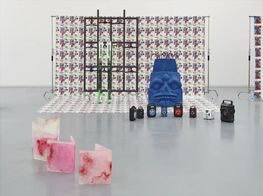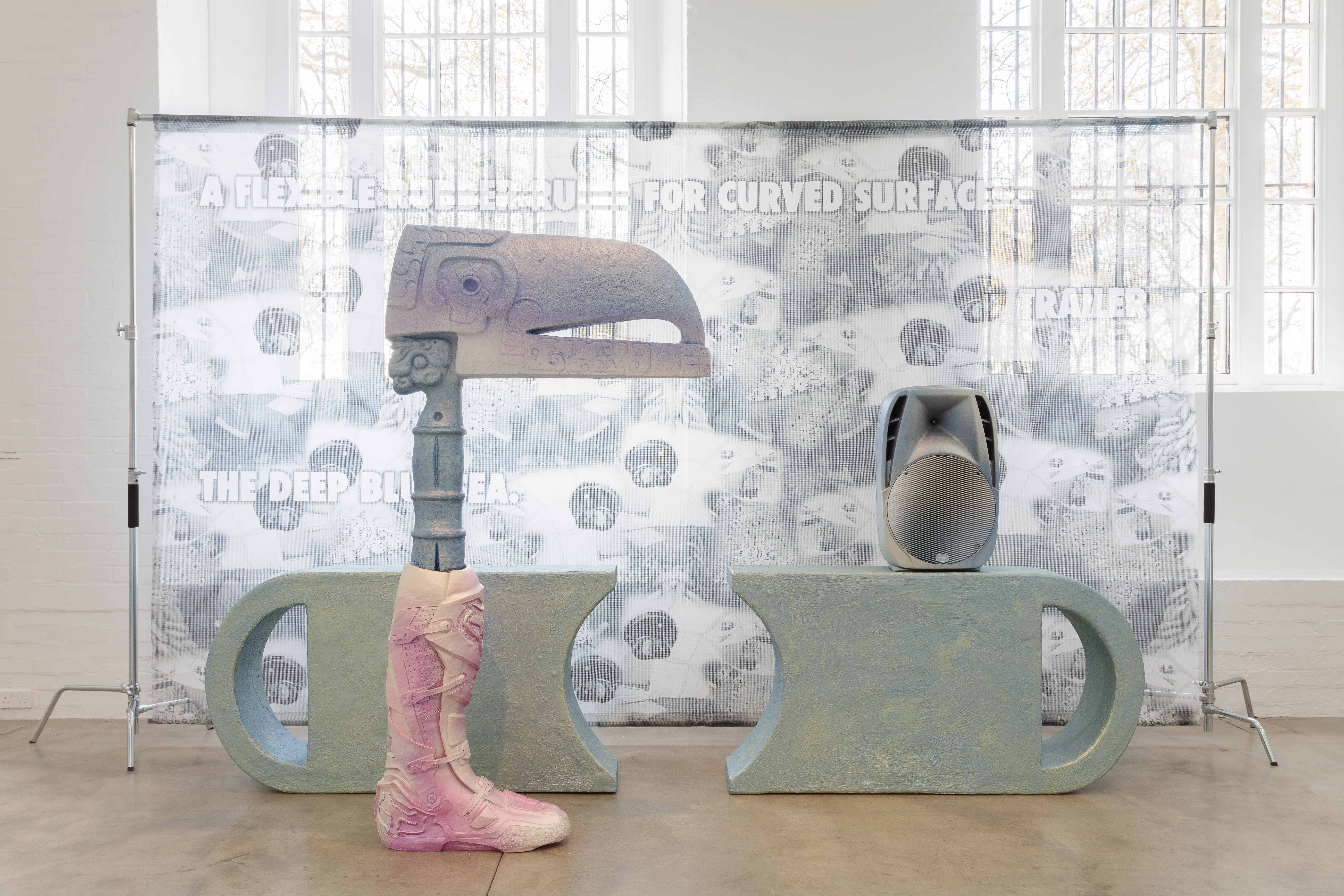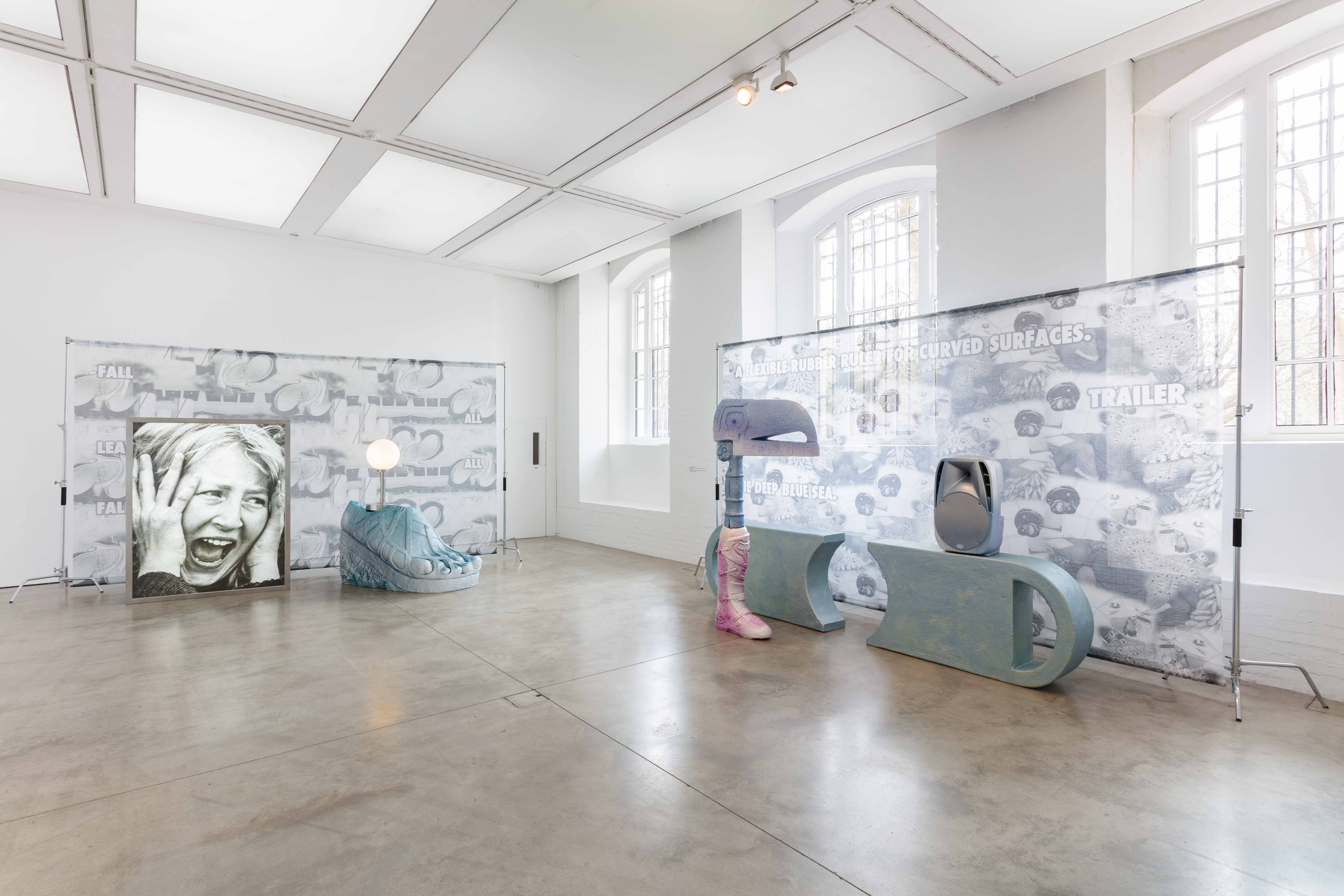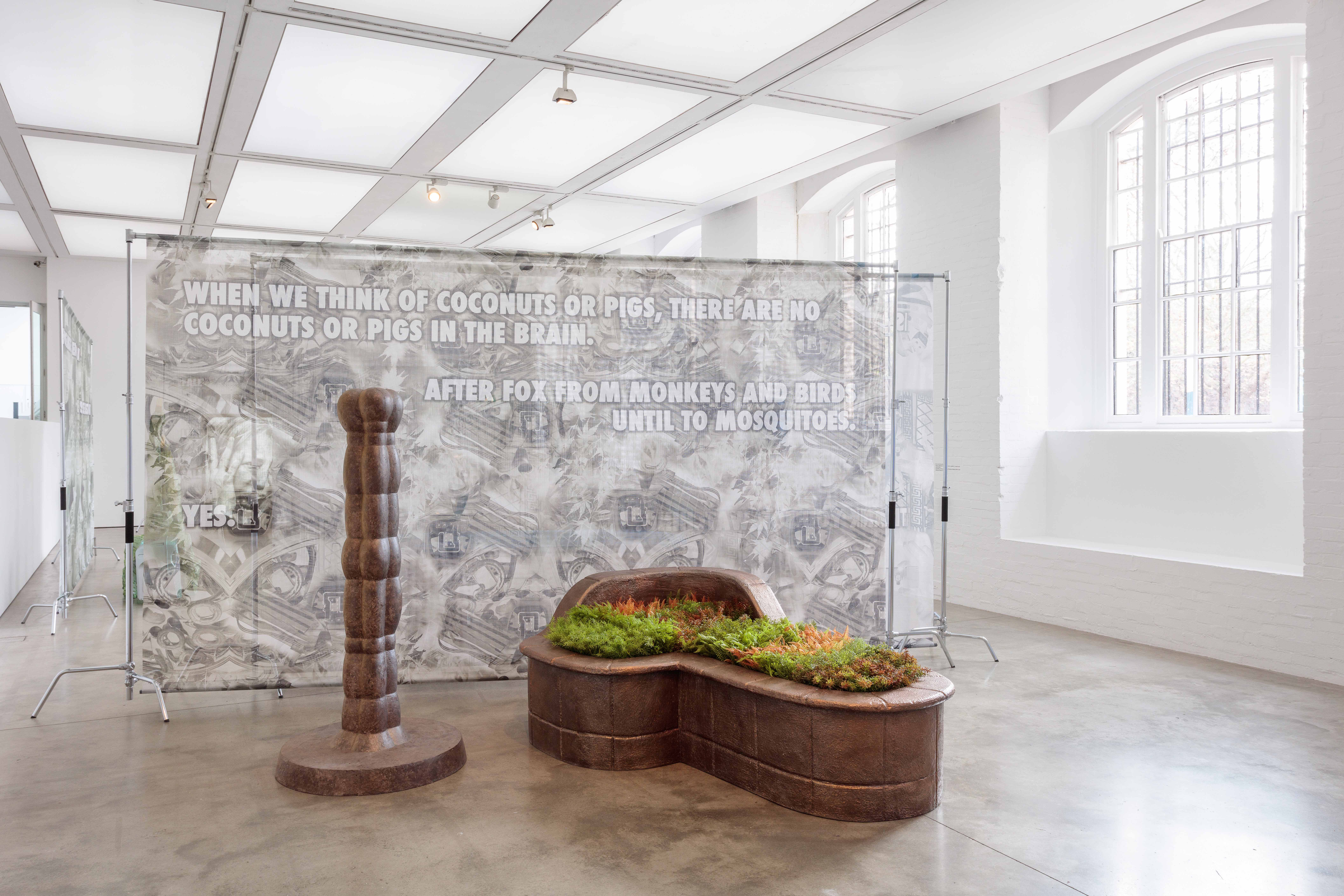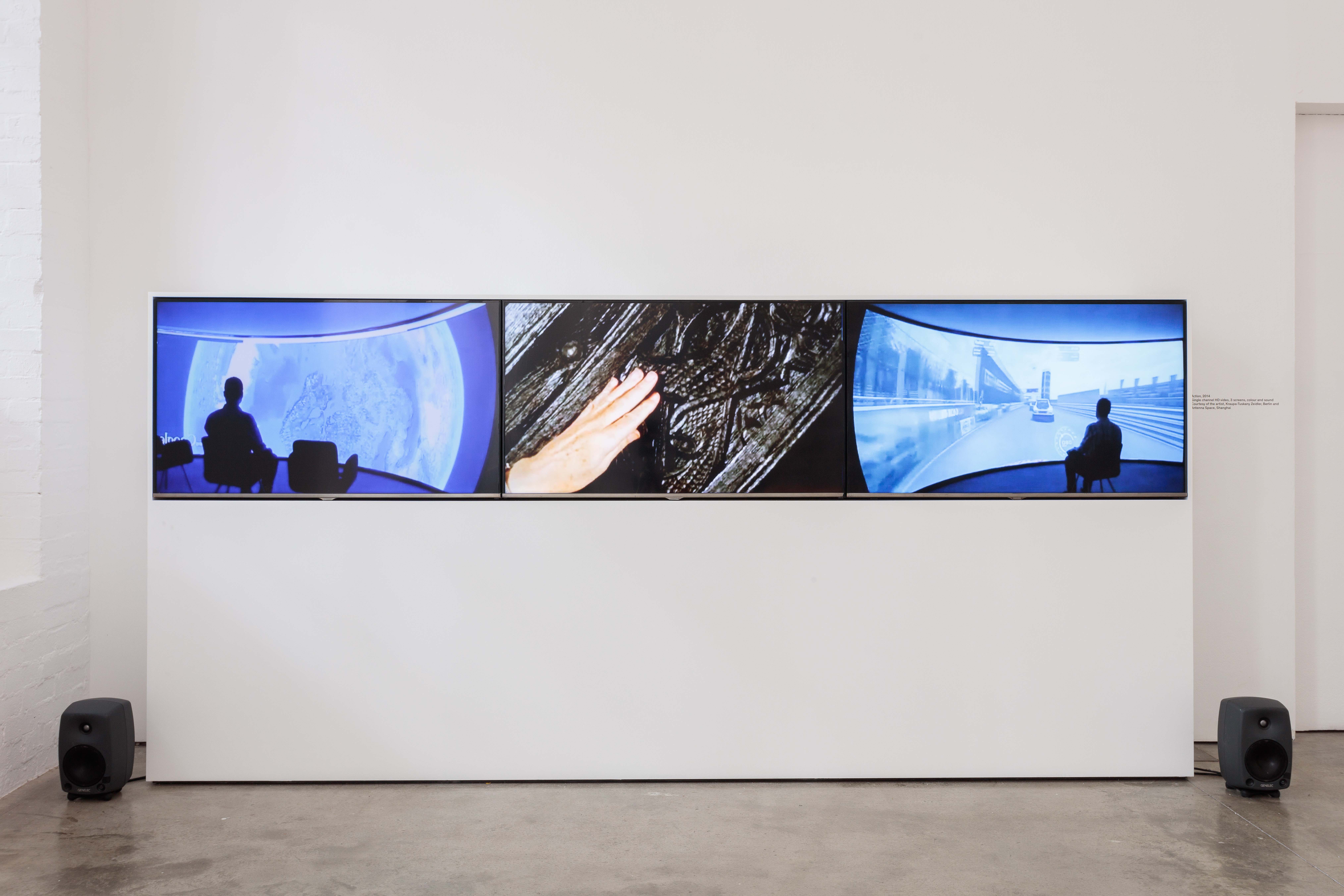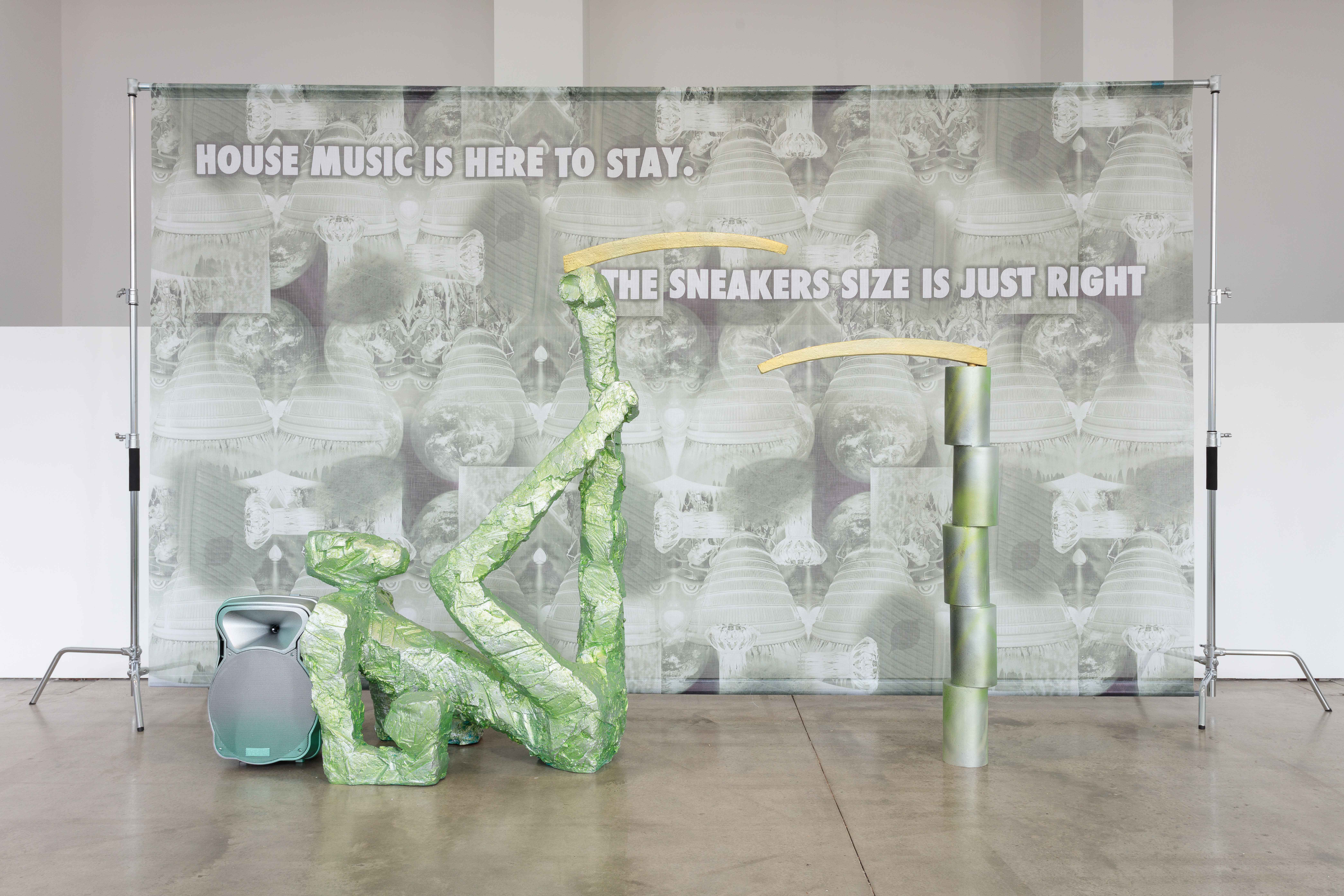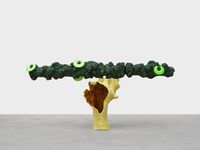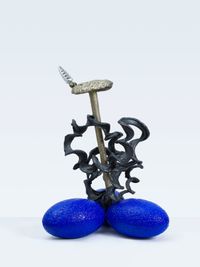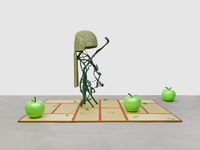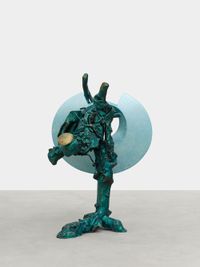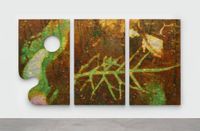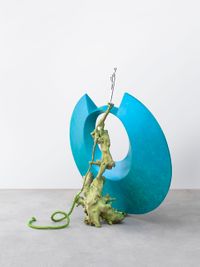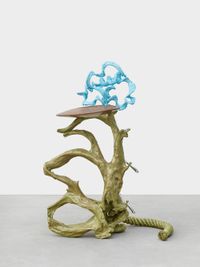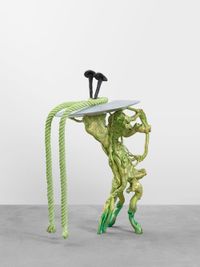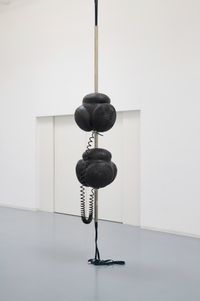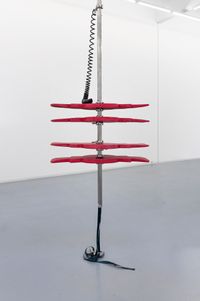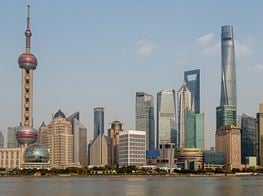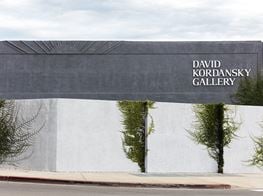Guan Xiao
Guan Xiao. Courtesy the artist.
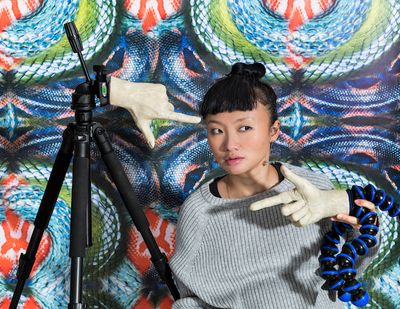
Guan Xiao. Courtesy the artist.
This year has been an important one for Guan Xiao. In April, the Institute for Contemporary Arts in London showed the artist's first exhibition in a United Kingdom institution.
Entitled Flattened Metal (20 April–19 June 2016) and organised in association with K11 Art Foundation, the ICA show was a perfect articulation of the artist's practice thus far, incorporating a concise body of work that investigates relationships with time and matter.
The exhibition consisted of a number of her 'sets' that combine audio sound and backdrops with a series of 'props'. The props included a pair of neon pink speaker phones on which an electric blue surfboard rested, presented in front of a greyscale backdrop printed on mesh screen and offering a digital collage and printed texts, including: 'THANK YOU FOR WATCHING'.
The artist's show was well received: it marked at once an arrival and a departure in terms of how this artist is moving through the world, processing its material information as she goes.
In Shanghai this year, the ICA exhibits will form the core of a new show, Guan Xiao: Elastic Sleep (9 November–8 December 2016) which will be presented at the K11 Art Foundation exhibition space in Shanghai. Between the ICA show and the Shanghai show, Ocula spoke with the artist about her work.
SBLet's start by talking about the title of your recent exhibition at the ICA, Flattened Metal—what does this mean to you, and are titles important to you as an artist?
GXIn the beginning, I tried to find a title that articulates and interprets the intentions of the work in a straightforward way. But soon I realised I was trapped in my least favourite method, so I changed my perspective. Metaphor is the cleverest form of rhetoric: an appropriate way to communicate. For me, Flattened Metal is more precise than going straight to an interpretation of the intentions.
If I say a word to you, like '-ism' or 'post-', you wouldn't understand its precise meaning if you didn't already know the background of these words. But anyone is capable of knowing what 'flattened' and 'metal' mean, with their different ideas and understandings. For me, this type of abstract perception processed by the imagination of an individual is the essence of the communicated object: the true 'precision'. 'Flattened Metal' has a sense of condensing and transforming complexities into something different, resembling the work of visual artists who use similar traits to transform complex objects.
Titles are important. My installations can be described as different components—including the titles—gathered together in a way that brings forth a backdrop that does not seem to focus on any single subject.
SBThe sculptural installations you present in Flattened Metal are quite different to those you made earlier, such as The Documentary: Geocentric Puncture (2011–2012), where you presented composed photography studio settings. There artefacts, such as an Easter Island Moai statue, were positioned in front of brightly coloured camouflaged screens resembling snakeskin.
Could you describe the formal, compositional and material thinking that went into composing this installation—in terms of the arrangement of text, screen, sound, and object? What is the significance of the number of screens, for example, and the texts and objects you chose to use, and how did the video triptych you created for the show fit in to the narrative that you composed?
GXThrough my installation works, I've been trying to describe a context, rather than provide a subject, even if they appear to exist independently. From The Documentary: Geocentric Puncture (2011–2012) to The Documentary: From National Geographic to BBC (2015), I was influenced by the arrangements of photographic studios, trying to blur the focus within the structure of the installation, compositions of elements and the range of complexities, to create multiple subjects or an absence of subject.
In a photographic studio, the backdrop is used to emphasise the object being photographed, and I intentionally used colourful and complex snakeskin patterns for these backgrounds to make the objects at the front and the background equally important—all their colours, degrees of complexity of detail and importance being blended together. Although the works showing at the ICA are stylistically different, the internal lines of thought align to the previous practice.
The choice of colours came out of personal preference. I like images that are colour-reversed through Photoshop, so I tried to approach that in the colour scheme of the show. The paleness of the metallic colours was based on those gradient options in Photoshop that reflect those digital colour inversions. Compared to previous works, for me the deliberate grey scaling and mild colour schemes I used for the ICA show are just another type of sharp contrast.
I want the relationship between the installations to be fused better, with my treatment of the backdrop not only letting the installation itself be able to describe a context, but also transforming the space. So this time I chose a semi-transparent mesh fabric, hoping the visuals, like colour and texture, would overlap between installations, making the background, foreground and environment lighten and fuse.
SBIs there a particular way in which you want people to relate to your works, in terms of how you condense, compress and flatten time and meaning within them?
GXThere are internal relations within the works that I experiment with. It's not that people lack the abilities of imagining and perceiving, but there needs to be a gap to allow people to believe what they actually feel. Hence, for the exhibition at the ICA, I didn't design complex relational structures between compartments; on the contrary I controlled solely the most basic elements, such as the volume of the works and their positioning. How they are to relate to each other became an unspeakable abstract component to be returned to the audience. However, I'm still offering them 'elements' or 'keywords' as usual.
SBWhat keywords would you say you utilised for your London show?
GXI've retained my preference for sculptural forms, putting two conceptually opposing objects together: ancient sculptures and modern ready-mades, limited edition art objects and endlessly reproduced public facilities, and so on. But the readers should know that this is not my only standard of selection. After all, for me anything is a material, including concepts. For instance, while this time I chose the stereo set as the main ready-made, I don't need its speakers to function; what I need is the concept of 'stereo set' and its relationship with sound.
I don't need the presence of sound here. I just need people to think of any sort of sound they could have imagined when they first saw the stereo set. It is just as I treated the photography equipment, I don't need it to actually work; I only need the concept of it and its relationship with seeing. Therefore the words I use are like the other components in the installations: they are just different materials of a medium. The references in the words, the meanings behind them, their contexts are not so important to me. The words and the stereo set exist as a set of conceptualisation materials, broken up from their former existence. Their literal meaning at this time becomes the shape of their being as materials. One thing to note is that different installations represent different word combinations and structures.
SBHow does this relate to not only the three-screen video work you included in Flattened Metal, but also to your work with video and multi-screens in general?
GXThis becomes a more complicated question when it comes to the relationship between multi-screens and my videos. I love TV shows that feature a host introducing an artwork in a gallery or museum, or programmes that show spectators visiting an exhibition. I also like travel shows featuring a presenter explaining objects that the camera points at—I find these mostly on YouTube. On some occasions, the camera replaces the role of the host, and then we are able to see the exhibit and the spectators at the same time.
Different perspectives and ways of seeing are emphasised in these videos. The presenter's voice, the exhibits and the viewers (we may also include the host here) become three different types of media which when put together form an image. I'm interested in the fact that the three components are at the same time distinctive and in tune.
What makes this kind of film different from feature films and documentaries is that in these, one can easily differentiate the three things involved: the scene, the host, and spectators. Feature films by contrast tend to merge different components as much as possible: the actors, scene, storylines and voiceovers, and so on. These sorts of clips do not speak their entirety through images; what emerges is rather some scattered keywords—the images can be described as different components gathered in a way that brings forth a backdrop, without focusing on any one subject. These different perspectives motivate my interest in using the triptych format. It allows the flexibility of spectatorship: the members of the audience are themselves the consumers and agents implicated in a new scene.
I suppose the sense of time has a strong presence in a single screen, but is weakened and even resolved in three. This is an important aspect, and another reason why I chose to work with three. Although my installations and videos appear to exist independently, video functions on the basis similar to my installation works in which I try to describe a context rather than prove a subject. But due to the differences of media languages the actual ways of working differ. Objects of perception are a complex but unique multiple; it's born out of the combining effects of various elements and methods. To deliver a clear message of this kind through objects of perception, a linear logic cannot be followed. For my videos I used the analogue of the forming process of my objects of perception as my means of communication, and to hide the intentions underneath a carefully fabricated phenomenon, letting it grow into a precise shape from intentionally created chaos.
SBYou said that Geocentric Puncture marked a turning point for you in terms of bringing the old and the new together. Does Flattened Metal mark a development in your practice at all?
GX'Putting together the new and the old' is only one way of 'putting two conceptually opposing objects together'. Because I think two opposing concepts are often coming from the same abstract perception. And the emphasis of the development on this concept lies in how to define and present different opposing concepts. But Flattened Metal as a round-up exhibition doesn't take this point as the main direction of discussion. Its presentation is only a part of the work.
SBOne aspect of your work is the intention to reveal how—as you have said—the things we deem as new or modern are in fact ancient, too, which is something your work expresses through the compositional logics you appear to employ in order to manipulate apparatuses of seeing. In the case of Geocentric Puncture, for instance, we see both the camera that documents fragments of history, to the fragment itself, and the frame within which the representation is staged. In Flattened Metal, it feels like you have employed a similar approach, but instead, we are no longer in a camera studio, but in a museum—a place in which we see, for instance, a large Grecian foot—a fragment, a viewer might imagine, of a larger statue—as an object of monumental time.
Would you say Flattened Metal continues your exploration into the notion time as expressed through the objects that define who we are culturally and historically?
GXMy statement that 'the new or modern things are also ancient in some perspective' is based on the influence on us of things such as archaeological artefacts and latest technological products that may escape from the constraints of meaning due to our insufficient understanding or unknowing of them. Also because of unknowing, the abstract language of forms can escape its functionality into an independent narrating subject, and so be full of imagination.
How the audience understand my works must be a free and also very personal act. My works don't provide a standard answer. Hence what the composition and structure of my works lead you to think about is your own business. However, with all the materials I use, I don't care about their references, history, the meanings behind them or their contexts; for me they exist here as conceptualised materials, broken up from their former existence. The reason why I prefer using conceptually opposed objects is not only because paradoxical, polarised things often come from the different expressions of the same perception, but also because they can further emphasise this fracture, and liberate things from their historical and functional meanings, and thus from taxonomy. In my work, history has never been of my concern. For me history is a lump of recycled things in changing packages, some accumulating materials.
In some ways the human race has never progressed, we keep moving in cycles, repeating ourselves. I try not to make the audience think that I'm talking about the historical values of things. Therefore, personally I don't like the saying 'the fragments of history'. On one hand if we see certain forms and think of them as the fragments of history, it's too symbolised; on the other hand, nothing in my work is a fragment 'of history', at least not as in the meanings of what most people would think the 'fragments of history' might be. They are themselves.
You asked whether Flattened Metal continues my exploration into the notion of time as expressed through the objects that define who we are culturally and historically—I don't necessarily agree with this. I think there's an implication being created here, that limitations created by culture and history become a deliberate discrimination, and are intended to induce a value system. This means is not only too symbolised, but is also an interference and abduction of perception. Besides, time for me is a measure word, a measurer. My intention has nothing to do with this measure word. At last, as the author, my works do not expressly talk about 'who we are' type of identity issues.
SBHow might this also feed into your conception of space and place? I ask this with your participation in Don't You Know Who I Am? Art After After Identity Politics (13 June 2014–14 August 2014), the major group exhibition organised by M HKA (the Museum of Contemporary Art Antwerp_),_ in mind. In that exhibition you presented The Documentary: Geometric Puncture (2012) and the video work Cognitive Shape (2013), a three-screen installation in which we see a visual timeline of world history through its artefacts, from Neolithic arrowheads to roller skates. Some of the images we see in that video work, in fact, reappear in London.
GXFollowing my answer to the last question, the relationships I consider between works and space and locations are within cognitive domains. As for how do I consider the relations with space in the exhibition at the ICA, I have already delivered a relatively detailed explanation. But what makes me curious is, you would think that in Cognitive Shape that a visual timeline of the world history would be presented. The actual purpose of the animation is the opposite: it intends to deliver a timeline that is messed up, a viewing state that is an arbitrary tiling. This is also the reading state when browsing the Internet nowadays.
SBThis is what I meant when I described Cognitive Shape as an exploration into the notion of time as expressed through the objects that define who we are culturally and historically—it is a frame in which time is materially flattened in much the same way you produced in The Documentary installations. In other words, all things—from a scuba diving suit to a Neolithic arrowhead—are placed on the same expansive plane, like 'arbitrary tiling' to use your words.
But knowing how you feel—or don't feel—about identity, or perhaps definitions and frames in general, I'm curious how you, as an artist working in the art world today, felt about your participation within the exhibition at M HKA, which sought to explore cultural and political complexity through a post-identity frame?
GXFor the exhibition at M HKA, the curator had a clear curatorial topic, and each artist presented different levels of the topic. My view on the identity issue is: I don't approve any discrimination/identification by nationality, history, culture, geography, and so on. I recognise only one identity that is 'human'. Apart from this, any other identification for me is a concept that may change and transform constantly.
The different identities are not the point, the point is how to transfer between these different concepts. In my recent exhibition, Weather Forecast (7 June–25 September 2016) at the Jeu de Paume in Paris, curator Heidi Ballet had the same discussion about identity, and the cultural and political complexity after identity politics. In the publication for the show, there's a more detailed documentation on my views about identity. As for the exhibition at the ICA, although it is my first solo show in London, identity and historical issues are still not the focus for me, as usual.
SBCould you tell me how Flattened Metal will combine with Electric Sleep and other works in your upcoming K11 show in Shanghai?
GXThey (the works) have different focuses of expression; and the media is diverse as well. We cannot explain it like a thesis. Firstly, they are all practises of mine; I am the point of connection. Secondly, in the first question I have briefly introduced the core value of my works, and that is where they are internally connected.
SBYou once said your work is very much about betraying the world while being loyal to it in your own way. To this end, what advice would you gives to those who wish to become artists in the future?
GXThat refers to a sentence by Gotthold Ephraim Lessing in Hannah Arendt's Men in Dark Times, which she quotes: 'Always ready to betray and stand against the world, while staying loyal to it in my own way'. The last time I mentioned it, it was more about my attitudes towards art, rather than about the creation of works. For me, this is a mentality an artist should have. A mind that is always alert and observing the surroundings in the opposites of experience and 'should-dos', but this is not some kind of clever strategy, but a responsibility and loyalty to the self and the world.
When I first got into the art world, there was a senior who told me three sentences: 1. Never do what you don't want to do. 2. Be polite. 3. See your goal, and go for it.
I want to add another: As long as you hold on to it, you will have a position for yourself. —[O]

